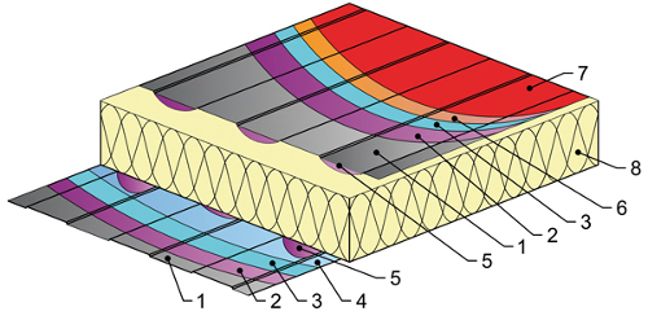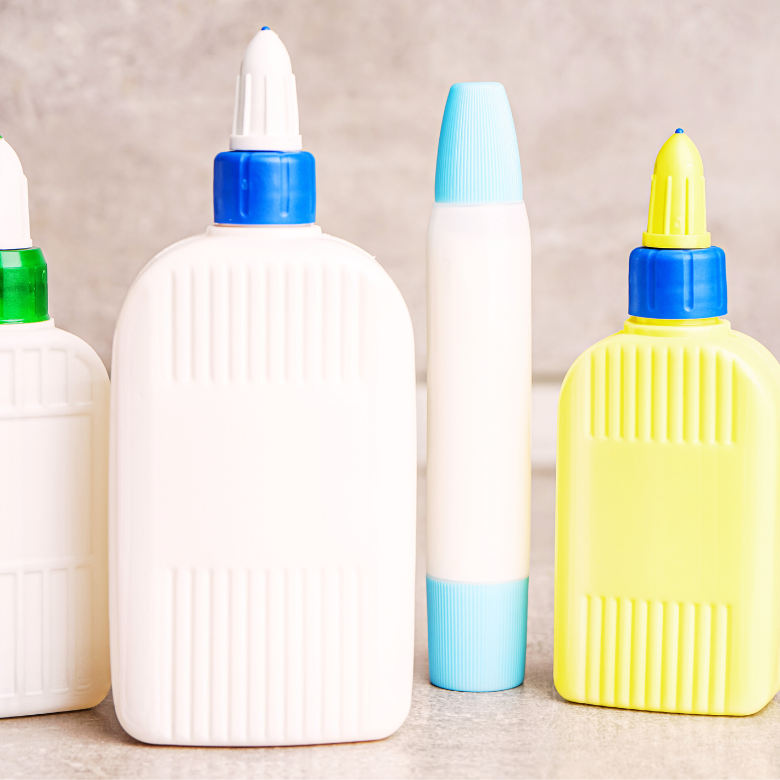Polyurethane adhesives are definitely a milestone in the construction industry. They are characterized by the use as a primer used for the production of sandwich panels, whose core can be made of XPS, polyurethane or mineral wool. So what are polyurethane adhesives, what are their types and advantages?

What are polyurethane adhesives?
Polyurethane adhesives are a type of adhesives characterized by exceptional adhesion and elasticity, which are the result of polymerization of components containing isocyanates and polyols. These products form bonds with high resistance to weather conditions, temperature, water and various chemicals.
Importantly, they are more resistant to the action of water, solvents, oils and other chemicals compared to traditional adhesives, and also exhibit high resistance to weather conditions and UV radiation. Therefore, their application is particularly valued in sectors requiring shear and tensile strength, i.e. construction, automotive or furniture production.
Key properties of polyurethane adhesives
- Adhesion. High adhesion capacity to many types of surfaces, e.g. metals, wood, plastics, ceramics and concrete. Their molecular structure allows for the
creation of strong bonds with various substrates, which is crucial in ensuring the durability of joints.
- Flexibility. This property is particularly valued in applications where materials are subjected to dynamic loads, thermal expansion or other mechanical deformations.
- Chemical and weather resistance. This includes hydrolysis, ozone, UV radiation and many chemicals, making them ideal for outdoor use.
- Thermal durability. This allows them to be used in both very low and high temperatures.
Structure and production of sandwich panels
The production of PWS panels is one of the latest technologies. These sandwich panels consist of skin and a structural-insulating core. In the production cycle, the core and the skin are connected using polyurethane adhesive. More and more often, the connection of several insulating sheets is performed by milling. The core of the panel is made of materials such as polyurethane foam (spray insulation), mineral wool, expanded and extruded polystyrene and others. Below is the structure of an example sandwich panel. Regardless of its purpose, properties or manufacturer, such a panel with a steel skin should consist of:
- two steel sheets, with any profile, which constitute the outer skin. They determine the appearance of the board and are responsible for functionality, especially under in terms of design;
- thermal insulation layer, which is located inside and provides adequate thermal and acoustic insulation parameters, and is also responsible for maintaining the appropriate distance between the skin, adequate the forces acting in the system.
The standard PN-EN 14509:2013-12 “Self-supporting double skin metal faced insulating sandwich panels – Factory made products. Intended uses. Specifications.” states that a product with such design can be a self-supporting structural element.

Fig. 1 Example of a sandwich panel structure: 1 – steel core of the sheet, 2 – zinc coating, 3 – passivation layer, 4 – protective varnish, 5 – adhesive, 6 – prime coat, 7 – decorative surface layer, 8 – thermal insulation material core. http://www.inzynierbudownictwa.pl/technika,materialy_i_technologie,artykul,lekkie_pokrycia_z_plyt_warstwowych,9890
Types of polyurethane adhesives
Polyurethane adhesives are available in two main types: one-component and two- component. Their division mainly affects the method of application, and consequently the scope of use in individual industries.
One-component adhesives
One-component polyurethane adhesives are formulated so that they contain all the necessary components in one mixture. Their curing process begins after the adhesive is applied to the surface and exposed to air.
One-component polyurethane adhesives are used in many fields, including construction, automotive and furniture production, offering good adhesion properties and resistance to weather conditions and chemicals. In addition, they are appreciated for their ease of application.
Two-component adhesives
Two-component polyurethane adhesives consist of two separate components which must be mixed just before use. The first component is polyol, and the second is isocyanate. Mixing these two components initiates a chemical reaction that leads to the curing of the adhesive.
This category of adhesives offers higher strength and better resistance to extreme conditions, which is why they are used where special mechanical strength and chemical durability is required (for example, in the construction industry, when assembling heavy elements).
Example: https://www.products.pcc.eu/en/id/638728/sil-pur-80-3/
Use of polyurethane adhesives in industry
Polyurethane adhesives have a wide range of applications in various industries due to their exceptional properties, i.e., high mechanical strength, flexibility and resistance to various weather conditions and chemicals. The following sectors deserve special mention as they use adhesives most frequently: construction, industry, and automotive.
Construction
Polyurethane adhesives in construction are used due to their durability, elasticity and resistance to weather conditions. They are considered ideal for joining structural elements, such as wall panels, roof or floor insulation, as well as for installing windows and doors.
Wood and furniture industry
In the wood and furniture industry polyurethane adhesives are valued for their strong bonds and resistance to moisture — so important in the production of furniture and other wooden products. Additionally, they are used to join various components, from wooden frames to laminated surfaces.
Automotive
Used, among others, in the assembly of windows, body elements and in the components of vehicle interiors. Their use enables the achievement of light, but durable vehicles, which translates into better performance and greater fuel efficiency.
Packaging industry
In the packaging industry, polyurethane adhesives are used for the production of multi- layer packaging that requires strong and durable bonds. Their resistance to water and oils makes them ideal for food, cosmetics or chemical products packaging, where the integrity of the packaging and the protection of the contents are a priority. These adhesives are used in both flexible and rigid packaging, ensuring safety and durability during transport and storage of products.

Advantages of polyurethane adhesives
#1. High resistance to weather conditions
Polyurethane adhesives are particularly resistant to weather conditions (e.g. moisture, temperature and UV radiation), which is why they are perfect for external applications, where other types of adhesives could quickly degrade.
#2.Elasticity
Polyurethanes are characterized by natural elasticity, which allows adhesives to maintain durability and integrity even in the case of dynamic loads, vibrations or changes of temperature. This elasticity is key in applications that require the ability to stretch and twist without cracking or breaking.
#3. Strong bonds
Polyurethane adhesives create exceptionally strong bonds between various materials, including metals, wood, plastics and concrete. The strength of these bonds results from the deep penetration of the adhesive into the micropores of the materials, which increases the force of adhesion. This makes them an excellent choice for furniture production, structural assembly and any applications requiring impressive durability.
Read more: adhesives for plastic
#4. Fast curing
Many polyurethane adhesives are characterized by a relatively short curing time, which is important in rapidly changing, dynamic production environments. Additionally, fast curing allows for the acceleration of assembly and production processes, increasing efficiency and reducing downtime.
How to properly apply polyurethane adhesives? Practical tips
1. Surface preparation
Before applying a polyurethane adhesive, make sure that the surfaces to be bonded are clean, dry and free of grease and other contaminants. Thorough cleaning of the surfaces may involve degreasing with a solvent and light matting.
2. Thorough mixing (for two-component adhesives)
If you are using a two-component adhesive, thorough mixing of components A (polyol) and B (isocyanate) is crucial for achieving optimal bond strength. Follow the recommended proportions provided by the manufacturer and mix the components thoroughly to ensure a uniform chemical bond.
3. Applying the right amount of adhesive
More is not always better. Using too much polyurethane adhesive can lead to overflow that, when it leaks out of the joint, becomes unsightly and difficult to remove. Too little adhesive, on the other hand, may not provide sufficient bonding strength.
4. Control of environmental conditions
Polyurethane adhesives react with moisture, so it is important to control environmental conditions during application. Too high humidity can accelerate the curing process, shortening the working time, while too low humidity can delay it. Optimal conditions for most polyurethane adhesives are room temperature and moderate humidity.
Manufacturers’ offering
The PCC Group, as a producer of specialty chemicals, in its portfolio also offers two-component and one-component polyurethane adhesives. One example of a two-component adhesive is Ekoprodur 1331B2. It stands out as an adhesive for PWS polystyrene foam panels, but also for panels with a core of mineral wool or polyurethane. It is worth emphasizing that it is characterized by a reduced emission of volatile organic compounds (VOC), thanks to the fact that it does not contain foaming agents that cause depletion of the ozone layer. Another proposal for a two- component adhesive is RokaPur PR2K 105 K and Ekoprodur KW1.
Among the products, we can also find Ekoprodur KW-A2 (which is a polyol component) and EKOPROMER G20, which are components of two-component polyurethane adhesive. EKOPROMER G20 can also be used in construction alone as a one-component adhesive. Its characteristic feature is the durable bonding of building materials together and excellent adhesion.
Among the available adhesives for EPS or fiberboards, which can be joined with sheet metal, an example of a single-component product will be EKOPRODUR RB-2. It is a pre-polymer based on diphenylmethane diisocyanate (MDI). It is characterized by its versatility, is also easy to use and can be applied manually, e.g. with a spatula, but also mechanically. It is characterized by a high temperature tolerance during application, as well as excellent adhesion to substrates made of various materials. Other single-component adhesives that
you can find in the offering this RokaPur PR1K_15 (one-component primer for sandwich panels).
We offer a wide range of polyurethane adhesives, which differ in unique properties suitable for various applications. However, their key role is in the production of sandwich panels and this is a future direction in the construction industry.
- http://inzynierbudownictwa.pl/lekkie-pokrycia-z-plyt-warstwowych/
- https://www.sciencedirect.com/science/article/abs/pii/B9781845694357500031
- https://fastenerandfixing.com/products-plus-tools/pros-and-cons-of-polyurethane-adhesives/